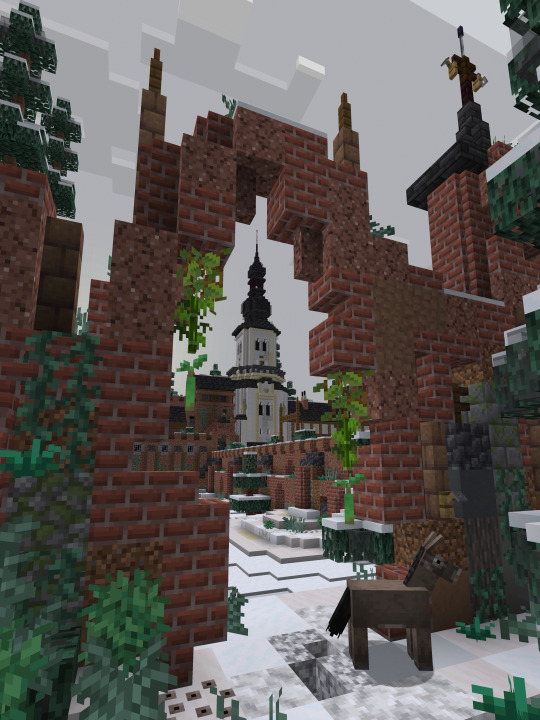#castle tower ruins
Explore tagged Tumblr posts
Text









#aesthetic#old architecture#exterior decor#vintage aesthetic#antique#ancient#old building#ruins#castle#tower#classic architecture#stone building#pillars#doorway#gateway#hallway#exteriors#arched windows#antique decor#dark academia#buildings#academiacore#vintage vibes#classical#academia aesthetic#explore#wanderlust#cottagecore#architecture#antique aesthetic
542 notes
·
View notes
Text

Minecraft snowy ruins
#minecraft#minecraft project#minecraft art#minecraft build#art#minecraft house#minecraft house idea#minecraft screenshots#minecraft builder#project#minecraft castle#minecraft castle idea#castle#minecraft castle design#minecraft castle tower#minecraft town#minecraft ruins#ruins#minecraft trails and tales#minecraft snow#minecraft winter#minecraft vanilla#minecraft 1.20#minecraft spruce#minecraft tree#winter#minecraft church
3K notes
·
View notes
Text

Encounter VI. Ink on paper. 33x48 cm
#ink and brush#ink drawing#black and white art#ink#traditional art#art#dark#dark fantasy#tower#castle#ruins#fantasy environment#rpg#roleplaying#illustration#darkness#gloomy#dungeon synth#goth#gothic#dark academia#dark romantic#forest#hidden#old tower#dark tower#old fantasy#inkart#blackandwhite#monochrome
61 notes
·
View notes
Text

87 notes
·
View notes
Text






Ireland 2024 - Blarney Castle and poison garden (2) (3) (4) (5) (6) by Sara Ream
#castle#ruins#towers#gardens#flowers#wisteria#scotch laburnum#calla lily#poison hemlock#complicated tree#ireland#county cork
40 notes
·
View notes
Text

Château du Ramstein, Alsace, France
#middle ages#castle#tower#ruins#archeology#architecture#history#Europe#Elsass#Holy Roman Empire#Ramstein#Scherwiller
41 notes
·
View notes
Text

Castelo de Melgaço, Portugal, 8-11-24
#Castelo de Melgaço#Portugal#8-11-24#photography#photo#photographers on tumblr#aesthetics#aesthetic#medieval history#medieval ruins#medieval castle#castle#ruins#tower#civil architecture#architecture#medieval architecture#monument#knightcore#knight aesthetic
22 notes
·
View notes
Text

Bradgate Country Park 21st October 2018 Steven Hart
#england#united kingdom#autumn#fall#nature#orange#landscape#fall aesthetic#photography#ruins#castle#architecture#tower#architecture photography#Bradgate House
8 notes
·
View notes
Text
(follow-up to a previous poll)
#nintendo switch#nintendo#castlevania#castlevania dominus collection#konami#dawn of sorrow#portrait of ruin#order of ecclesia#haunted castle#nintendo direct#pizza tower#pizza#indie games#thank goodness you're here#tgyh
11 notes
·
View notes
Text




Huis Bergh, 's-Heerenberg, The Netherlands
Then 13th-century castle is one of the largest in the Netherlands. It also houses an art collection of Italian paintings and sculptures from the medieval period.
#travel#netherlands#the netherlands#nederland#travel photography#photography#castle#ruins#middle ages#medieval#historical#medieval art#13th century#italian art#museum#art museum#history#architecture#photographers on tumblr#medieval architecture#castle architecture#fortress#tower#greenery#garden#trees#heraldry#coat of arms#culture#dutch culture
10 notes
·
View notes
Text

The haunted tower
9 notes
·
View notes
Text





Soft snow signs in O'dyllita
[EU] Unikornu
#black desert online#black desert#bdo#black desert screenshot#screenshot#non edit#bdo discord#screenshot submission#odyllita#narcion#verdure doe#verdure buck#castle ruins#tower ruins#chasing snow in odyllita is pen bs rng#family unikornu#eu
22 notes
·
View notes
Text

🏰Fortress of Tustan, Ukraine
📜𝕸𝖊𝖉𝖎𝖊𝖛𝖆𝖑 𝖈𝖑𝖎𝖋𝖋-𝖘𝖎𝖉𝖊 𝖋𝖔𝖗𝖙𝖗𝖊𝖘𝖘-𝖈𝖎𝖙𝖞
#ukrainian culture#medieval#medieval aesthetic#castle#fortress#medieval fantasy#fantasy aesthetic#fantasy#castles#ruins#castle ruins#tower
14 notes
·
View notes
Text

Vestiges de muraille et de tour, château, Uzès, Gard, 2016.
12 notes
·
View notes
Text

Tower of the ruined medieval castle in L'Isle-d'Abeau, Dauphiné region of eastern France
French vintage postcard
#medieval#tarjeta#dauphiné#postkaart#castle#dabeau#sepia#lisle#ruined#eastern#historic#france#photo#l'isle-d'abeau#postal#briefkaart#photography#tower#vintage#ephemera#ansichtskarte#old#postcard#french#region#postkarte#dauphin#carte postale
8 notes
·
View notes
Text

Tour d'angle, Château du Landsberg, Alsace, France
#middle ages#castle#ruins#corner tower#tower#archeology#architecture#history#Europe#Elsass#Holy Roman Empire#Heiligenstein#Landsberg#Heimat
6 notes
·
View notes